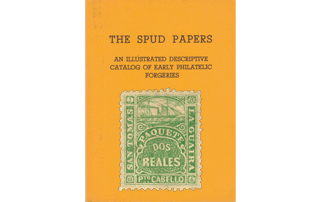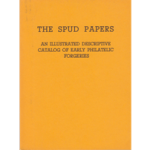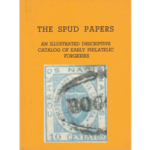Spud Papers – La Guaira
Of the stamps issued in 1864, there were two designs, one engraved in this country, with the value expressed in reales, and used for the franking of letters from La Guaira to St. Thomas; the other, with value in centavos, was of native make, and freed letters and papers between St. Thomas and the ports of Venezuela.
1,2, 3, and 4 Centavos.
Genuine
Not badly engraved, and with linear ground straight and regular. Sixteen lines from the top to shading representing waves, and right hand mast of vessel going through the fifth line. Ornaments clearly shown, and period following each word.
Forged
The whole execution is wretched, the lined background being more or less broken and irregular throughout; the masts of the steamer are taller than in the genuine, and the right hand one touches the third line. The ornaments in the upper angles, and at base of the central rectangle, are shapeless and smudged. There is no stop either after PACKET or CABELLO.
1864. 3 C., Black on Yellow.
There have been several forgeries of the stamps of this series, but this 3 C. seems to belong to a new set of forgeries; at all events, I have never met with it before, and it is quite distinct from the two sets of forgeries which I described in The Philatelical Journal, and again in The Stamp-Collector’s Magazine, vol. XI., pp. 73. 74. In some respects it is better than either of the above-named forgeries, but I do not think I should call it a dangerous forgery.
Genuine
Lithographed, in rather oily-looking black ink, on dull yellow paper; imperf. The outline of the stamp is formed of one thin black line. There is a large dot under T of ST., another after GUAIRA, and another after CABELLO. There is a very tiny flag on the mainmast of the steamer. The masts are very nearly the same height, and neither of them comes near the top of the containing rectangle. The 3 has an extra outline on the right side. The scroll containing CENTAVO is very plainly discernible, and is rounded at both ends. The stop after CENTAVO is on the outline of the scroll, and the letters (all except the C) are joined together, top and bottom, by thin lines following the curve of the scroll. There is a small oblong ornament under NTA of CENTAVO. The smoke of the vessel does not reach the edge of the frame. The horizontal lines in the background are very clear, and are drawn at regular distances from each other.
Forgery
Lithographed, in jet-black ink, on bright yellow paper; imperf. There are two distinct forgeries on the same sheet. The first has the horizontal lines in the background very clearly drawn, and the L of LA is only half its proper height. In the other the horizontal lines of the background are badly done, especially behind the 3; and the L of LA is the same height as the A. The following description will apply to both, unless otherwise specified. The outline of the stamp is formed of two thin lines, which run together on the right side, forming one thick line. No. 2 forgery has a very tiny dot under T of ST. In most copies there is no stop at all after GUAIRA and CABELLO; but if there is a stop after the one, it is not visible after the other; so that those copies which have a stop after GUAIRA, have none after CABELLO, and vice versa. There is a very distinct flag on each mast. The main-mast is very much higher than the fore-mast, and touches the inside of the frame, almost under A of GUAIRA. The 3 is an ordinary figure. The scroll containing CENTAVO is very badly drawn, especially in No. 2 forgery, and the right end is not rounded off. The stop after CENTAVO is inside the scroll. The letters of CENTAVO are not joined together. There is no oblong ornament under the NTA of CENTAVO. The smoke of the vessel touches the inside of the frame, opposite the S of THOMAS. These forgeries are not postmarked.

 Medio and Dos Reales.
Medio and Dos Reales.
Of the genuine there are two dies, varying chiefly in the corner numerals, and in the portion containing ship. The earliest were those with small figures, and considerable shading over the steamer; these were always with small perforations. When the large serpentine denticulation was adopted, the second die was introduced, and in it we find no shading above the vessel, and larger figures in the angles.
The forgeries are copies of the first die, and are either imperforate or with dents a little larger than in the genuine piques. The best and most simple mode of testing one of the Spiro-made La Guaira of this type, is to compare it with the specimen here given, for both values of it are from one matrix, with merely the number of Reales altered.
As the originals were engraved by Waterlow and Sons, no one should be deceived by such trash as these forgeries.
187O. 1/2 Real, Green.
Genuine
Lithographed (?) on yellowish wove paper; pin-pricked 10, or perf. 13. The outside line of the frame is scalloped all round, with 15 scallops at top and bottom, and 17 down each side. There is a stop after each of the letters J. A. J., and-the horizontal lines of the z are carried beyond the knobs which ought to end them. The scroll containing the value almost touches the frame on each side. There are two ornamental tongues sticking out of the centre of the left side of the body of each J. The steamer’s mizen is set, and can be readily seen.
Forged
Lithographed, on white wove paper; pin-perf. 13. The principal and easiest test is the number of scallops round the frame. There are 16 at top and bottom, and 20 at each side. There is no stop after the last J; the stop after the A. is not very distinct, and the Z is like an ordinary capital z. The ends of the value-scroll are at some distance from the sides of the frame. There is only one ornamental tongue sticking out from the center of each J, making these letters look more like F than J. The steamer’s mizzen-sail is not set, though the gaff (or boom, or whatever it is called) is plainly visible.
Postmarks
The genuine stamps generally bear a double circle blue or black, containing large letters (CORREOS, & C.); and the forgeries have four concentric circles in black, and no lettering. The gum on the genuine is yellow; the forgeries are ungummed.
1870. 2 Reales, Rose.
Genuine
Lithographed (?) on yellowish paper; pin-pricked 10, or perf. 13. The outside of the frame is composed of a scalloped line all the way round. There are 15 scallops at top and bottom, and 17 at each side. There is a stop after each of the letters J. A. J., and the top and bottom of the Z are carried a little beyond the small knobs which usually finish off that letter. The figure 2 in each corner is very short and fat. The scroll containing DOS REALES just touches the inner line of frame, under TO of FTO. There are two ornamental tongues or curves in the center of the left side of each J; the G of GUAIRA is rather like a C; the Q of PAQUETE has a long tail; the letters TO of PTO are nearly as thick as the P, though much smaller.
Forged
Litgraphed, in bright red, on white paper; perf. 13. This forgery may be speedily detected by the number of scallops in the outer line. There are 16 at the top, 15 at the bottom, 19 on the right side, and 21 on the left. There is no stop after the last j; the stop after A is not very distinct, and the z is like an ordinary capital Z. The figures of value in the corners are tall and thin and are not all alike. The value-scroll does not touch the frame anywhere. There is only one ornamental curve or tongue to the left of the center of each j, which makes these letters look more like F than J. The G of GUAIRA is like a G; the Q of PAQUETE has a very short tail.
The letters TO of PTO are very thin and faint.
Postmarks
The genuine stamps are obliterated usually with a double circle (blue or black) containing large lettering (CORREOS), whilst the forgeries are cancelled with four concentric circles in black, and no lettering. The gum on the genuine is yellow, whilst the forgeries are ungummed.
From “The Spud Papers” by Atless, Pemberton & Earée, 1871-1881.




Leave a Reply
Want to join the discussion?Feel free to contribute!